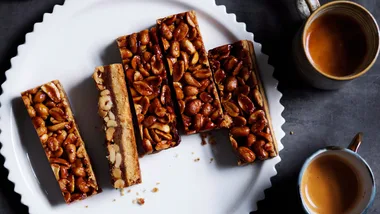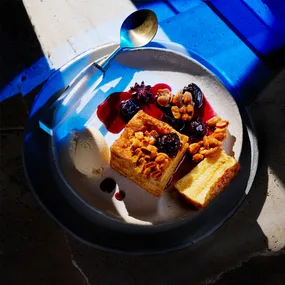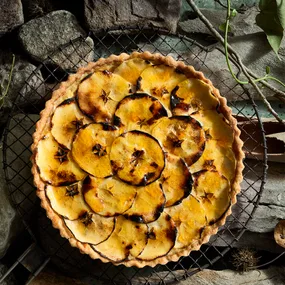When the weather turns cold, our thoughts turn to the most comforting of comfort foods, including this classic dessert from Britain: bread and butter pudding. In this traditional version, the sultanas are soaked in brandy for extra plumpness and the custard is scented with vanilla seeds, cinnamon and orange rind. The scattering of sugar over the top gives the pudding a delicious crunch. You can serve with ice-cream if desired, too. Sweet as.
Bread and butter pudding recipe
Ingredients
Method
Combine sultanas and brandy in a small bowl and set aside to cool.
Combine eggs, cream, milk, caster sugar, orange rind, vanilla seeds and cinnamon in a jug. Whisk vigorously to combine and set aside.
Spread both sides of bread slices with butter and halve lengthways. Scatter one third of the brandied sultanas into a lightly greased 1-litre capacity ovenproof dish. Trim bread slices to fit dish and layer, scattering remaining brandied sultanas between each layer. Pour cream mixture evenly over bread slices and stand until bread has completely absorbed cream mixture (about 1 hour).
Preheat oven to 180C. Scatter demerara sugar over pudding and bake until golden and custard is firm (30-40 minutes). Serve immediately or at room temperature, lightly dusted with icing sugar, and with scoops of vanilla ice-cream or cream to the side, if desired.
What is bread and butter pudding made of?
In its simplest form, bread and butter pudding is made of bread, butter, custard and currants, or a similar dried fruit like the sultanas in this recipe. This basic recipe has been part of the traditional British culinary repertoire since the early 17th century, evolving from the more simple bread pudding. This was as ideal way to use up stale bread, which was simply steamed and enriched with a variety of mixtures (from fruit to meat) before baking.
When more luxurious produce – such as eggs, milk, sugar and butter – became readily available, the bread and butter pudding was born. Stale, buttered bread was soaked in a sweetened custard (sometimes scented with nutmeg or citrus rind) before being studded with currants, poured into a baking dish and baked in the oven.
Modern recipe variations
The ingredients in this classic remained more or less the same up until the mid-to-late 20th century, while the pudding languished in relative obscurity (think school dinners and nursery food). But the revival of traditional British cooking and the rise of the British gastropub in the ’80s and ’90s led to a revival of the pudding – along with some new takes on the classic recipe.
No longer satisfied with making it from simple white bread, chefs developed more exotic creations of bread and butter pudding, with fancy breads such as brioche or panettone and even stale croissants, often generously laced with a variety of spices and liqueur.
In The Oxford Companion to Food, Alan Davidson says that bread and butter pudding “can also be made with something more exotic than plain bread… and can be enlivened by judicious spicing or by reinforcing the currants with plumper sultanas and mixed peel. But such elaborations must be kept under strict control, so that what is essentially a simple pudding does not lose its character under the weight of sophisticated additions.”
5 tips for making bread and butter pudding
- Remember to give the butter time to soften (if it’s cold). This makes it easier to spread it on the bread and grease the baking dish.
- Remember to pre-heat the oven, as this ensures the pudding cooks all the way through and the custard mixture sets properly.
- Use day-old or slightly dry bread so that it can absorb as much of the custard mixture as possible.
- Keep in mind that fresh or softer bread could mean a longer cooking time or a potentially mushy pudding.
- Make sure you bake your pudding until the custard is set. Every oven and baking dish is different, so it’s important to check your pudding as well as following the times in the recipe.
Want more recipes for bread and butter pudding?








